- Posted: Nov 09, 2023
- Updated: Jan 29, 2024
-
 Akesh Soni
Akesh Soni
LinkedIn Sales Navigator Advanced Search Filters – Detailed Guide

You're awesome, Akesh. Your Boolean search tutorial on LinkedIn is literally helping me find so many good leads in no time. Barry was jumping with joy over the phone—a rare sight, I must say.
"Thank you. You must be using advanced search filters on Sales Navigator well." I said.
"What advanced filters? What are you talking about? You only told me about Boolean search the other day, I am only using them on Job titles and companies" Barry replied, returning to his normal self, and now I had reasons to worry.
Akesh (me): We had limited time the other day. I tried miserably.
Barry: What do you mean by that? You had one job: to tell me everything about Sales Navigator's search. How would I know?
Akesh: Alright, my bad. I will tell you about these advanced search filters. Once learnt, you can find which companies have received funding recently or are actively hiring for the services you provide so you can target them effectively, and even identify who is active on LinkedIn so sending an InMail on LinkedIn would be better for those leads.
Barry: Wow, you get all this info from LinkedIn? You better start running to Third Wave Café, dude, I'll be there in 30 minutes.
Akesh: I'll have two large cappuccinos.
I reached early, waiting for Barry. I saw him storming in with excitement and curiosity.

Barry: So, how do I find companies that recently got funding and are hiring?
Akesh: Not even a hello, my friend, always straight to business. LOL... at least allow me to enjoy a couple of sips of this delicious coffee.
Barry: You have the whole day to enjoy, from my side. Start talking.
Akesh: I love seeing your restlessness (chuckles).
For starters, LinkedIn Sales Navigator has 31 advanced filters for finding leads and 17 filters for finding companies as of November 2023.
Many of the advanced filters are straightforward, although a few have little nuances.
Tell me, do you want me to explain the lead filters or account filters first?
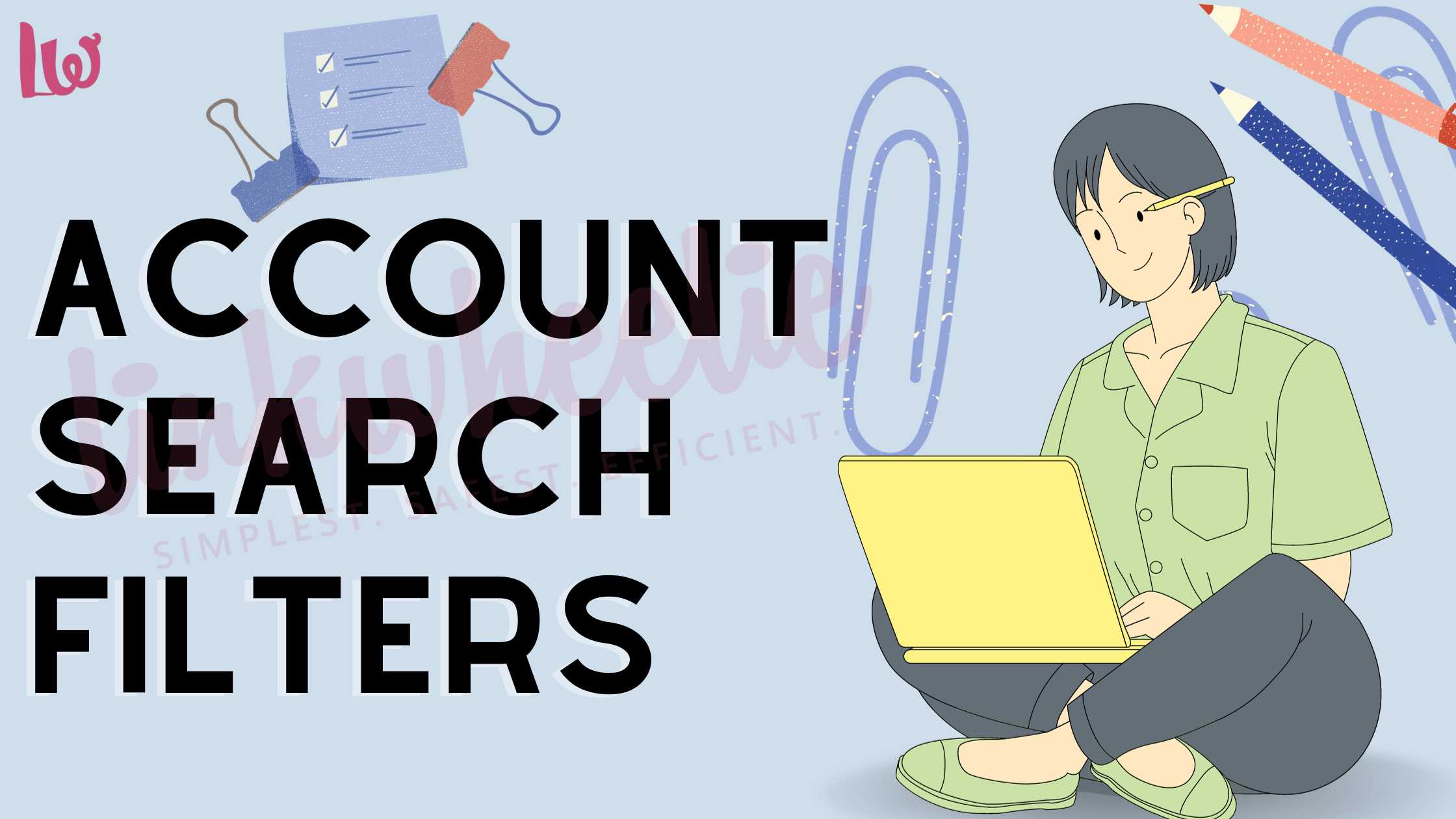
Barry: I love ABM; let's start with Account Filters first and then Lead filters.
Akesh: Sure.
To find accounts or companies on LinkedIn, they have three types of filters:
1. Company Attributes Filters, where you can use company-related parameters to shortlist. These are straightforward filters.
2. Workflow Filters, where you can include or exclude lists of companies you've saved on LinkedIn or companies in your CRM. There are customizable filters for each.
3. Spotlight Filters, These are the best filters. They help you obtain information about whether a company has received funding, is hiring, or what their buying intent is, etc.
Let's talk about the first category, Company Attributes Filters:
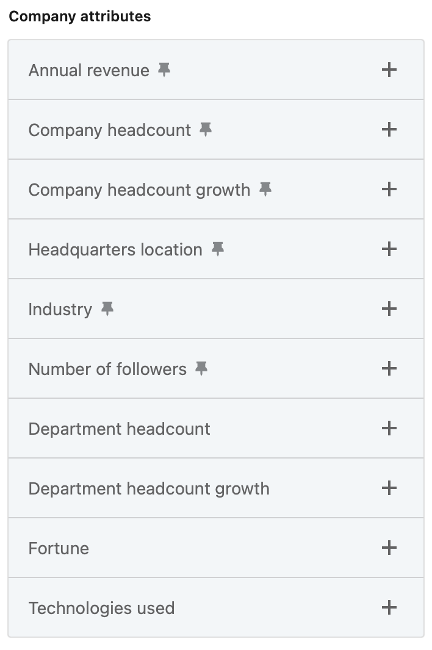
Annual Revenue: As the name suggests, you can shortlist companies with a range of annual revenue you want to target. You can select the currency and then put in a range.
I would recommend using this filter by broadening your expected range, since LinkedIn feeds this information from the web, and it can be outdated as well.
Company Headcount: You can use this filter to choose companies with a certain number of employees. The good thing is that it filters companies with employees who have listed this company as their current employer on LinkedIn. It doesn’t use or rely on the data of employees submitted by companies when creating their page on LinkedIn.
Company Headcount Growth: This is a good filter to find out which companies have been adding new employees in the last year. You can either limit the range by providing both minimum and maximum values, or you can use just the growth by a certain percentage by inputting only the minimum value.
You can find companies that grew in the last year by 15% or by 15-35% at most.
There are some other filters you can use too, like "Headquarters Location" to see where the company must be located, "Industry" to find companies within specific industries, or "Number of Followers" to find companies with a certain number of followers on their LinkedIn page.
If you sell to teams like sales or finance divisions in companies, then you can choose "Department Headcount" and "Department Headcount Growth" like above, where you can select a department like Sales, Operations, Accounting, etc., and apply filters.
There is also a Fortune filter which helps you find Fortune 50 to 500 companies.
It has one more filter named "Technologies Used" by companies, but I would not recommend using it as LinkedIn provides inaccurate results since this data is mostly not updated or is manipulated on the companies' LinkedIn pages.
The second category is Workflow filters:
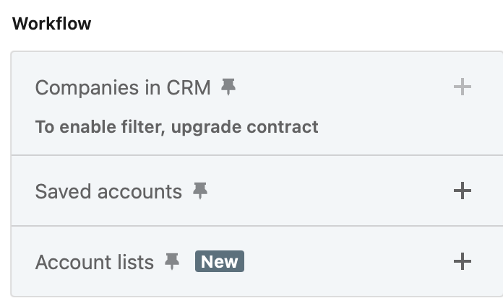
If you are a LinkedIn Sales Navigator Advanced Plus user, then you can use the 'Companies in CRM' filter; otherwise, it will prompt you to upgrade your contract to enable the filter.
You can include or exclude those companies in your CRM to filter; similarly, you can create Account Lists and Saved Accounts to include or exclude those companies in your search.
Expert Tip: The best use case of Account Lists can be to exclude companies you don’t want to come up in your search. Create an Account List, name it 'Exclusion List,' 'Blacklist,' or 'Do Not Contact List,' and add all those companies to be excluded from your future searches who are your current clients or not to be contacted for any reasons. Keep that list updated every week or month and include it every time you make a search.
The third category is the best one – Spotlight Filters.
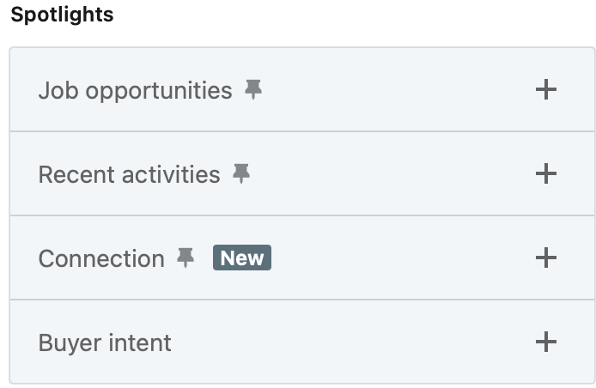
With the 'Job Opportunities' filter, you can find companies that are hiring on LinkedIn. These are the companies that have posted jobs on LinkedIn recently.
Expert Tip: If you are providing any service like recruiting, lead generation, SEO, or marketing, you can always find these companies who are actively hiring on LinkedIn for the same role and then reach out to decision-makers.
The 'Recent Activities' filter provides two options:
1. Senior Leadership changes in the last three months.
2. Funding events in the past 12 months.
You should jump on this information, since these could be the best triggers to reach out to any company to provide a service or a product.
Expert tip: Always approach those decision-makers after at least a month has passed since they joined the new company and offer value first rather than being salesy in your first pitch. They would still be gathering information on the new company's workflow and many other things before starting to make significant decisions.
'Connections' – a new filter recently added to the Account Filters page. You can use this to filter for companies where your direct connections, or 1st-degree connections, are working. This can be very useful to establish a link in a company you want to target.
'Buyer Intent': I would not recommend using this filter extensively unless your results are too numerous to manage. The reason being this depends mostly on interactions and engagement by employees of those companies with your company’s LinkedIn page. Moreover, this takes some other factors into account as well, and the results can be vague.

Barry: These are very good, advanced search filters to find companies, Akesh. Which ones are your favorite out of these?
Akesh: It depends on my need, Barry. I wouldn't stress much about company attributes filters except for company headcount, location, and industry if I am looking for small companies. That growth and revenue matter when we are trying to target large caps.
The 'Account List' filter is very good. I always use the 'Exclusion List,' which I created in my Account List for companies I don’t want to reach out to.
In Spotlights, my favorites are 'Hiring on LinkedIn' and 'Funding Events in the Past 12 Months.' Those give me the best trigger to start engaging with them.
I save all those accounts in one place to ensure I can see triggers on the Sales Navigator feed every day. So the moment a related activity occurs, I am onto it.
Barry: Smart! And don’t tell me Linkwheelie can export these companies to Excel or CSV too?
Akesh: It can. You can export all the companies directly to your mailbox. You can find more information on this in the article here.
Not only that, but the best part is also that by using Linkwheelie’s ABM Filter, you can find all the relevant decision-makers from all these companies without losing any filters.
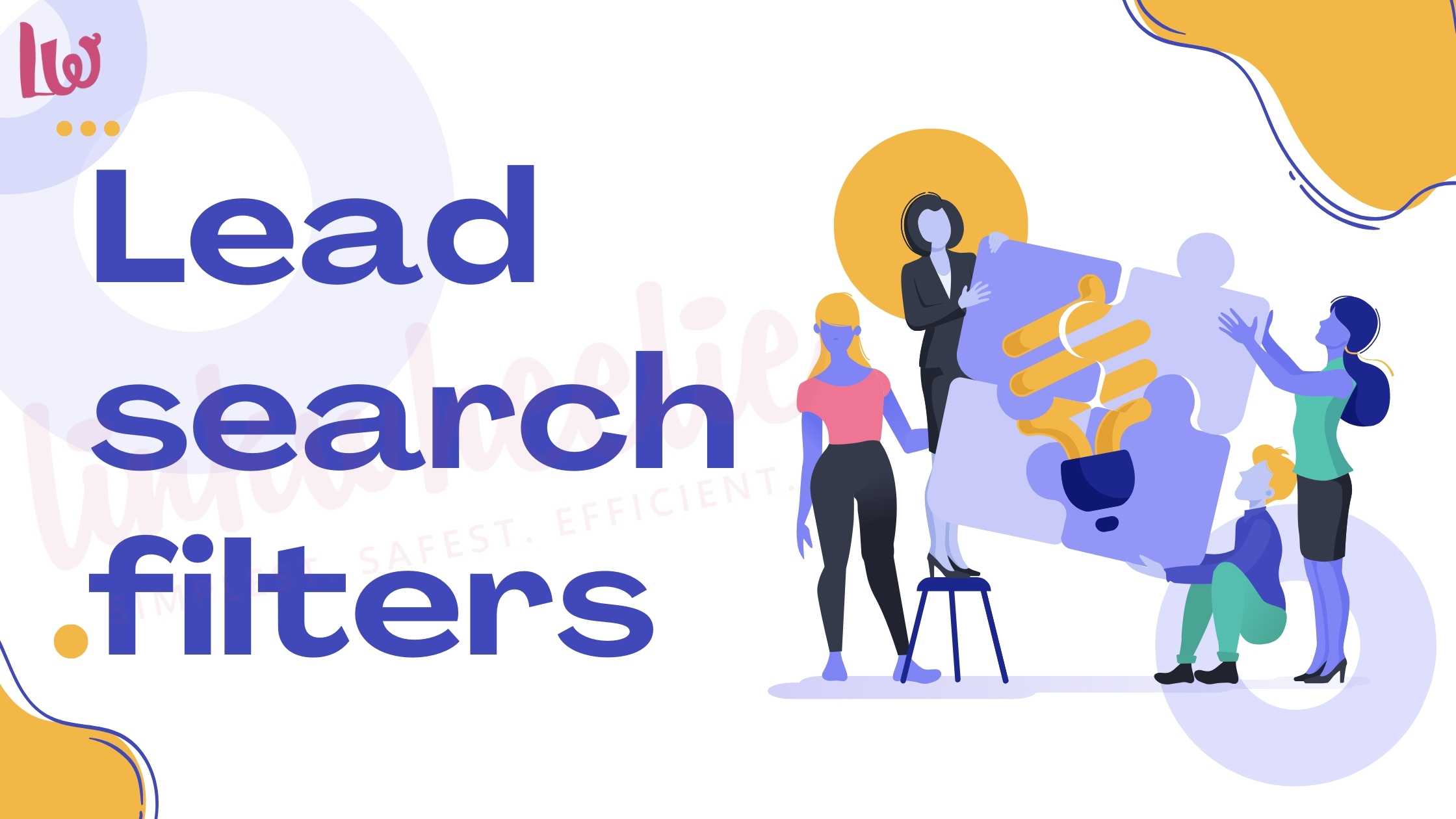
Barry: I know, that's a very cool feature. How about we mode to advanced filters for Lead search?
Akesh: Certainly, Sales Navigator provides nearly 31 filters, divided into the following categories:
1. Company Filters
2. Role Filters
3. Personal Filters
4. Workflow Filters
5. Buyer Intent
6. Spotlights
Let's start with the first category of Lead filters – Company Filters.
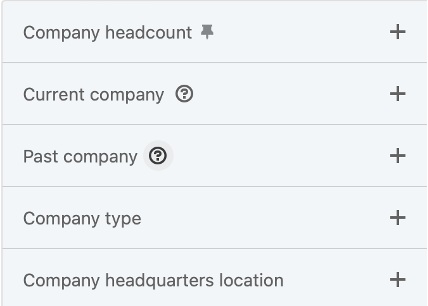
'Company Headcount' is the same as the one we used in Account Filters; you can find people from companies with a specific range of employees. You can search for individuals from small, mid-sized, or large companies depending on the number of employees.
The 'Current Company' filter can be used to find people currently employed at a company. You can use Boolean operators with this filter and enter as many companies as you wish to choose from.
A recent addition to this filter now allows you to upload a list of your companies/accounts into Sales Navigator and select that list to find people from only those companies. This saves you time and effort compared to writing out many companies using Boolean operators.
Expert Tip: Create separate lists of accounts for your current customers, past customers, target list of customers, and blacklist customers, then use them judiciously.
Similarly, the 'Past Company' filter lets you find individuals who have worked at specific companies. You can also use Boolean logic and lists with this filter.
Here's a catch for you – many people do not update their current employer as 'present,' or sometimes they mark more than one company as their current employer, which could lead to varying results.
The 'Company Type' filter is used to determine if you want to find people from companies that are privately held, public, nonprofit, etc. It's not a widely used filter, but it can be useful for specific searches.
The 'Company Headquarters Location' filter is useful since it allows you to target companies from a specific country or region if you export services or sell to a specific country. Remember, this filter identifies companies based on where they are headquartered, not the locations where they operate.
The next category is Role Filters:
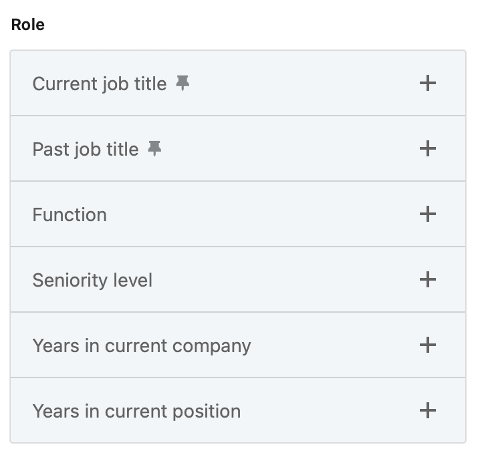
'Current Job Title' and 'Past Job Title' are two filters you can use to identify individuals in specific roles within an organization, whether they are currently or were previously in those roles. You can use Boolean operators with these two filters.
For example, if you're looking for people from big tech companies like Apple and Amazon who may have recently started their own startup, then enter Apple and Amazon in the 'Past Company' filter, select the 'Company Headcount' filter for less than 50 employees, and the 'Current Job Title' with the terms Owner OR Founder OR CEO.
Expert Tip: Don't just select the roles that LinkedIn suggests as you type in the job titles. Always use Boolean operators in these filters and write the job titles yourself within quotes. LinkedIn's algorithm tends to suggest many vague profiles if you only choose the roles suggested by LinkedIn.
The 'Function' filter allows you to find people working in departments like sales, accounting, engineering, finance, etc. However, I would recommend not using this filter and instead searching for people by their job titles, unless you have no idea what job titles your target audience might be using.
The 'Seniority Level' filter is designed to find people based on their hierarchical seniority within their companies. Again, I would generally not recommend using this filter because it can yield inaccurate results.
The 'Years in Current Company' filter and 'Years in Current Position' filter are meant to identify how long individuals have been in their role or with their company, as the name implies. Like other filters, there is a catch here: they can produce inaccuracies since many people do not update their profiles promptly. Use these filters with caution.
The next category of Lead Search filters is Personal Filters:
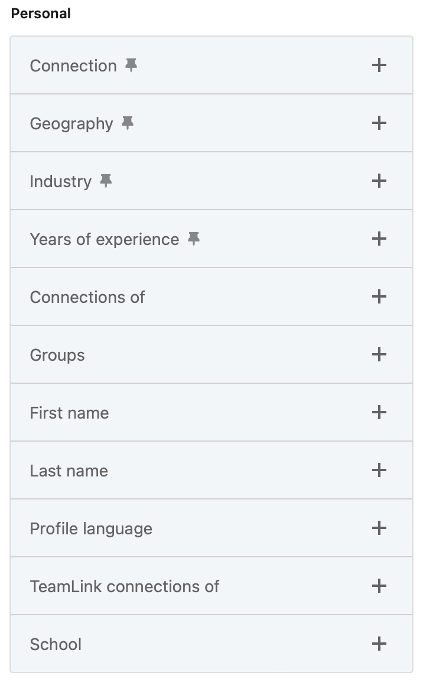
The Connection filter is an excellent tool to find leads with whom you already have a potential link. It can serve as an icebreaker to initiate a conversation.
You can identify 1st connections (directly connected), 2nd connections (someone who can introduce you), Group members (eligible for free InMail and provide a relevant point for an icebreaker), and TeamLink connections (your team member can introduce you).
Expert Tip: For me, Group Members and TeamLink connections have been the most useful for outreach to leads.
The geography filter will help you pinpoint the locations of your leads (people). Remember, this is different from the company headquarters location, as it considers the location that people have listed in their profiles as their current location.
The industry filter helps you find people in a specific industry. However, exercise caution with this filter; it does not consider the industry of their current company but rather what individuals have filled out as their current industry in their profile's experience section.
The Years of Experience filter assesses the total number of years of experience that people have listed in their LinkedIn profiles. It's not a frequently used filter but can be helpful for specific searches.
The ‘Connections of filter’ is one of my favorite Lead filters. You can use it to find the connections of anyone who is your 1st connection (directly connected with you on LinkedIn). The only catch is that they must have allowed their 1st-degree connections to view their connections list; otherwise, you will only be able to see mutual connections.
Expert Tip: Add your competitors as a connection, define your Ideal Customer Profile (ICP) on LinkedIn, use the 'Connections of' filter, enter your competitor's name, and save the search. You’ll continually see new connections added by them—and you know what to do next. 😉
The Groups Filter is one of the most underrated tools available to Sales Navigator users. You can find the most targeted leads from any LinkedIn group. You don't need to be a member of the group to use this filter, while typically, you would need to be a member to see other members.
Expert Tip: You can scrape and find emails of all the members of any LinkedIn group without Sales Navigator by using Linkwheelie. Here's how.
The First Name and Last Name Filters are self-explanatory and are only useful if you are trying to find a specific person.
The Profile Language filter identifies people based on the language they have selected for their LinkedIn profile. It's not commonly used since most people select English as their profile language on LinkedIn.
The TeamLink Connections of filter should be utilized as an adjunct to your search. It will only show those individuals connected to your Sales Navigator team members.
Thus, if you want to filter all your search results to see who is connected with your Sales Team, then this is the filter.
The School Filter can be instrumental in reaching out to alumni from a specific university or college. You can also use this filter to find individuals from a college you attended to personalize your outreach.
The fourth category is Workflow Filters:
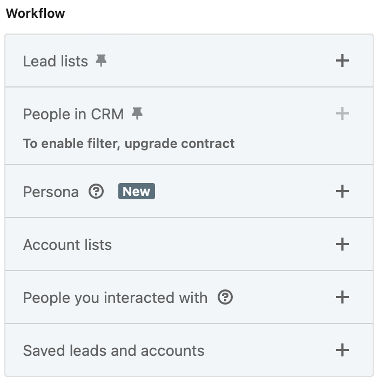
The Lead Lists Filter is utilized to sort through leads within your "all leads lists" or custom lead lists that you've created. You can include or exclude leads using these lists. This filter is extremely useful.
The Account Lists Filter can be applied to filter leads who are employed at companies listed in your "all accounts lists" or in the custom accounts lists that you've created. Similarly, the People in CRM Filter and Saved Leads and Accounts Filters can be used in the same manner.
The People You Interacted With filter provides you with two options: Leads you've viewed in the last 90 days or those you've messaged in the last two years on Sales Navigator. You have the option to include or exclude these leads from your search.
The PERSONA Filter, a recent addition, is a very powerful tool.
To use this, you first need to create a persona of your Ideal Customer Profile (ICP). You can find the personas link next to the keyword search on the Sales Navigator homepage.

When you click on Personas, you should see an option to create your persona, as shown in the image below.
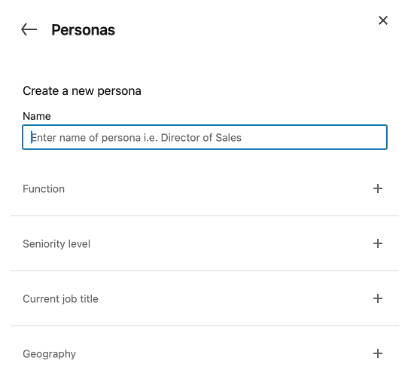
If you encounter difficulty in creating a persona, you can simply map one of your top customers.
Name the persona and if your top customer or market you sell is in the US or UK, then enter Geography as United States. You can add multiple locations.
Input the Job Title that your customer may hold, utilizing Boolean operators if necessary. Add multiple titles.
Remember, the more targeted you make it, the better LinkedIn's results will be.
Once you have finished creating a persona or multiple personas, you can then apply them in the Personas filter.
The next category is Buyer Intent.
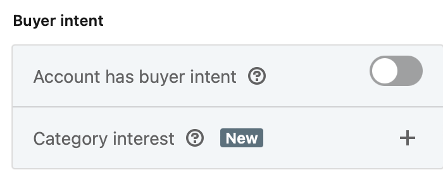
What is Buyer Intent? According to LinkedIn, Buyer Intent is gauged by metrics such as InMail and ad engagement, company page views, and profile views by individuals.
When you toggle ON the "Account has Buyer Intent" filter, it reveals those leads who work at accounts that have shown a high or moderate interest in your company in the past 30 days, calculated based on the aforementioned parameters.
The "Category Interest Filter" aims to display leads who have a potential interest in your product category, inferred from group membership, profile data, and other signals.
"Product Category Intent" (Category Interest) is a type of Buyer Intent but focused on the product level, not at the company level. It identifies individuals who might be interested in your specific product or solution, rather than in your company.
By employing the Category Interest filter, you can discover individuals who may have been searching for your solution but may not have heard of your company.
You must first set up the Product Category, after which you can utilize this filter, and LinkedIn's algorithm will present you with results.
If you activate both the Buyer Intent and Category Interest filters, you can use the following guidelines to interpret opportunities, as per LinkedIn:
· High/Moderate Buyer Intent + Active Product Category Intent: This opportunity is interested in your company and potentially in your product category specifically.
· No Buyer Intent + Active Product Category Intent: This opportunity might be seeking a solution like yours but may not have heard of your company just yet.
· High/Moderate Buyer Intent + No Product Category Intent: This opportunity is interested in your company but has not necessarily expressed interest in your specific product yet.
I would recommend utilizing these filters primarily for enterprise-to-enterprise sellers.
The next category is the most amazing one: Spotlights.
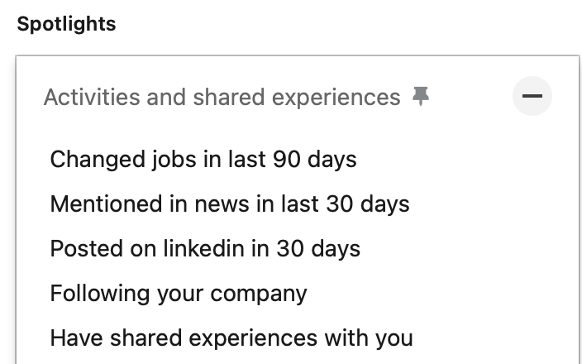

You can use the "Changed jobs in the last 90 days" filter to find executives who recently joined a company; they are most likely to make new decisions.
Use the "Mentioned in news in the last 30 days" filter to identify individuals and use that information as an icebreaker or to personalize your outreach. LinkedIn utilizes a news source list comprising over 800 news outlets to ensure excellent industry and geographical coverage.
You will be able to see news that was posted about them, which allows you to personalize your outreach.
I would recommend using the "Posted on LinkedIn in the last 30 days" filter the most if you want to reach out to people on LinkedIn. They are the most likely to respond to your message or connection request.
You will be able to see a link to their most recent post, and you can use that to personalize your outreach.
The "Following your company" filter is great for finding people who might already be interested in your services or your brand. Use this information as an icebreaker if you wish.
According to LinkedIn, buyers globally are 181% more likely to accept an InMail from a seller if they already follow the LinkedIn Page of the seller's company.
The "Have shared experiences with you" filter helps you find leads that have the same groups, schools, or past/current companies in common—providing you with a personal connection to leverage when reaching out.
With the "TeamLink intro" filter, you can discover new leads that a teammate can introduce you to. Your Sales Navigator team member would be a mutual connection to such leads. Those team members could be using the same Sales Navigator contract as your company, or they could be in TeamLink groups, or they could have only accepted a TeamLink Extend seat.
The "TeamLink intro through your executives" is a very powerful filter if executives in your company are willing to take the time to help you by introducing you to their connections. You can find connections of your company’s executives using this filter—imagine the impact.
The "Past Colleague" filter helps you find those leads who may have worked in the past at your current company.
The "Viewed your profile in the last 90 days" filter is self-explanatory. You can use this information when sending out a connection request, as they must have been checking you out for some reason.
That is it… I hope it helps.
Barry: Wow, this has been overwhelming. Do you have any other expert tips, Akesh?
Akesh: Yes, there are many, but I think we should delve into them next time. For now, I'll share one important trick with you.
Avoid using the Keyword search filter excessively; it scans the entire profile for that keyword. If you really need to use a keyword search, then consider performing an X-ray search on Google for LinkedIn profiles instead.
Wait, let me just give you an example—and let's not get bogged down in the technicalities of X-ray searches and Google searching for now.
Suppose you want to find all the people who are into business coaching. You would go to the Google search bar and type:
inurl:linkedin.com/in/ AND “business coach”.
By doing this, Google will return all the profiles that actually contain this keyword with near-perfect accuracy. This is because Google is permitted to crawl and index all LinkedIn profiles, and Google’s crawling is typically more refined.
Barry: Very interesting. It looks like we need to schedule another coffee tutorial for this. I thought I learned a lot today just by understanding Advanced search filters.
Akesh: You certainly did. And remember, you can find emails for all those leads by using Linkwheelie and scrape all the information from LinkedIn as well.
Barry: Yeah, yeah, I’m always on it. Linkwheelie has been a game-changer for me in finding emails from LinkedIn.
Akesh: Thanks, mate. See you soon… Remember, this is how I have been building XeroLeads where you can get list of high intent buyer-ready leads to sell your services or products.
Barry: Yeah, I am excited to check that out too...
Company
More
Copyright © 2025 All Rights Reserved Linkwheelie


 LinkedIn
LinkedIn
 Youtube
Youtube
 Careers
Careers